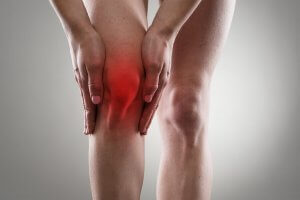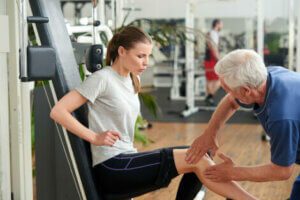Rehabilitation and Recovery from a Torn ACL

A torn ACL is a very serious and limiting injury. It stops you from playing sports and also affects daily life. Usually, you’ll need surgery in order to make a full recovery. We’ll tell you more about this injury and what to expect from rehabilitation and recovery.
Tearing the anterior cruciate ligament
The anterior cruciate ligament (ACL) of the knee is a tissue that runs from the lateral condyle of the femur to the anteromedial area of the tibia. That is, it starts at the back outer part of the knee, and goes to the front center. Therefore, it stabilizes the knee, preventing the tibia from moving forward with respect to the femur.
It’s a tissue that athletes commonly injure: stopping or abruptly changing direction with your foot on the ground can hurt it. Also, it happens if your limb is supported and there’s sudden trauma on the side of your leg.
Third, you can injure yourself. For example, you could try to kick a ball, but not make contact with it. In all of the above cases, the ligament can’t take the force, and it tears.
Because of this injury mechanism, the athletes most likely to tear their ACL are skiers, soccer players, and basketball players, among others.
Recovery from a torn ACL
There’s a small number of people who tear their ACL and don’t need surgery. This happens if the ligament doesn’t tear completely, and there’s still some joint stability. So, it’s an asymptomatic injury that lets them carry out their day-to-day activities.
In these cases, treatment consists of resting, retraining, and muscle strengthening. In addition, you may need proprioceptive work.

However, in most cases, the ligament tears completely. Then, the joint is very unstable and you’ll need surgery. Usually, arthroscopy is best, as it’s less invasive and complex, although there are other surgical options.
Rehabilitation from a torn ACL
The rehabilitation after surgery to repair a torn ACL generally follows this guideline:
First four weeks
In the first month after the operation, you’ll need to take care of the inflammation. Make sure you rest, apply ice, and elevate your leg with compression.
Second, now without stitches, start to flex your knee again to regain motion. Keep applying ice, and you’ll need to use crutches to get around. Also, take care of your scar tissue so you don’t have problems in the future.
From the third week on, you can start to learn to walk again. In addition, you’ll need to keep flexing and working on the general mobilization of your leg. In the fourth week, you can start with proprioception and cycling exercises.
During the second month
At this stage, recovery will focus on proprioception exercises, working on your rage of motion, and gradually increasing muscle strength. You’ll need to keep walking, but be very careful to not move in a way that will hurt your ACL.
From the third to the sixth months
This will be the last phase of the recovery that is considered necessary after a torn ACL. During these three months, you’ll be adding higher levels of difficulty to your workouts.

For example, you’ll increase the weight in strength exercises. Finally, you’ll start to gradually add exercises that include running, stopping, and jumping.
From here, you can return to your normal life. However, you’ll need to be careful; just because you recovered doesn’t mean you can’t get hurt again. In fact, if you play a sport, it might take more time to play as you did before your injury.
As always, you’ll have to start by performing safely. Over time, you can add imbalances, forces, complex movements, etc. If you follow each step, your chances of success are very good. You’ve got this!
A torn ACL is a very serious and limiting injury. It stops you from playing sports and also affects daily life. Usually, you’ll need surgery in order to make a full recovery. We’ll tell you more about this injury and what to expect from rehabilitation and recovery.
Tearing the anterior cruciate ligament
The anterior cruciate ligament (ACL) of the knee is a tissue that runs from the lateral condyle of the femur to the anteromedial area of the tibia. That is, it starts at the back outer part of the knee, and goes to the front center. Therefore, it stabilizes the knee, preventing the tibia from moving forward with respect to the femur.
It’s a tissue that athletes commonly injure: stopping or abruptly changing direction with your foot on the ground can hurt it. Also, it happens if your limb is supported and there’s sudden trauma on the side of your leg.
Third, you can injure yourself. For example, you could try to kick a ball, but not make contact with it. In all of the above cases, the ligament can’t take the force, and it tears.
Because of this injury mechanism, the athletes most likely to tear their ACL are skiers, soccer players, and basketball players, among others.
Recovery from a torn ACL
There’s a small number of people who tear their ACL and don’t need surgery. This happens if the ligament doesn’t tear completely, and there’s still some joint stability. So, it’s an asymptomatic injury that lets them carry out their day-to-day activities.
In these cases, treatment consists of resting, retraining, and muscle strengthening. In addition, you may need proprioceptive work.

However, in most cases, the ligament tears completely. Then, the joint is very unstable and you’ll need surgery. Usually, arthroscopy is best, as it’s less invasive and complex, although there are other surgical options.
Rehabilitation from a torn ACL
The rehabilitation after surgery to repair a torn ACL generally follows this guideline:
First four weeks
In the first month after the operation, you’ll need to take care of the inflammation. Make sure you rest, apply ice, and elevate your leg with compression.
Second, now without stitches, start to flex your knee again to regain motion. Keep applying ice, and you’ll need to use crutches to get around. Also, take care of your scar tissue so you don’t have problems in the future.
From the third week on, you can start to learn to walk again. In addition, you’ll need to keep flexing and working on the general mobilization of your leg. In the fourth week, you can start with proprioception and cycling exercises.
During the second month
At this stage, recovery will focus on proprioception exercises, working on your rage of motion, and gradually increasing muscle strength. You’ll need to keep walking, but be very careful to not move in a way that will hurt your ACL.
From the third to the sixth months
This will be the last phase of the recovery that is considered necessary after a torn ACL. During these three months, you’ll be adding higher levels of difficulty to your workouts.

For example, you’ll increase the weight in strength exercises. Finally, you’ll start to gradually add exercises that include running, stopping, and jumping.
From here, you can return to your normal life. However, you’ll need to be careful; just because you recovered doesn’t mean you can’t get hurt again. In fact, if you play a sport, it might take more time to play as you did before your injury.
As always, you’ll have to start by performing safely. Over time, you can add imbalances, forces, complex movements, etc. If you follow each step, your chances of success are very good. You’ve got this!
All cited sources were thoroughly reviewed by our team to ensure their quality, reliability, currency, and validity. The bibliography of this article was considered reliable and of academic or scientific accuracy.
- Reconstrucción del ligamento cruzado anterior. J. Vaquero, J.A. Calvo, F. Forriol. Trauma, Vol. 19, Nº. Extra 1 (Suplemento), 2008, págs. 22-38
- Ruptura de ligamento cruzado anterior en mujeres deportistas. L. Alanís-Blancas, P. Zamora, Á. Cruz. Anales Médicos de la Asociación Médica del Centro Médico ABC. 2012; 57 (2).
- Protocolo cinético en la rotura del ligamento cruzado anterior. G. López, L. Fernández, J. Gutiérrez, et al. Revista Española de Cirugía Ortopédica y Traumatología. Volume 55, Issue 1, 2011, Pages 9-18
This text is provided for informational purposes only and does not replace consultation with a professional. If in doubt, consult your specialist.








